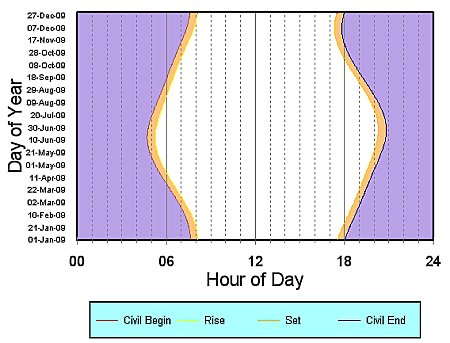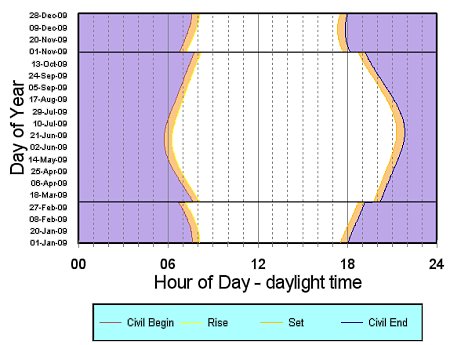Saturday, 07 November 2009
Saving daylight: So, what’s in the account?
(My previous post, mostly about Indiana’s time follies, is here.)
First, a few definitions:
Of the three types of twilight, we who live in urban areas are probably most interested in the first, Civil twilight. Although the sun is below the horizon, during that period there’s still enough sky illumination to allow “normal activities†without artificial lighting. (In Indiana the length of Civil twilight varies between 28 and 33 minutes.) At the end of Civil twilight in the evening, the sky is still light; but if you plan on doing anything outdoors it’s time to turn the lights on. During Nautical twilight sailors at sea can still make out the horizon clearly enough to do star sightings, but for those of us on land things just gradually get darker. By the time we urbanites reach Astronomical twilight any remaining sky illumination has usually been swamped by the glow of city lights.
Now let’s look at Daylight saving, or, rather, let’s first not look at daylight saving. Here’s a plot of the sunrise/sunset and Civil twilight data for Indianapolis for the year 2009. Violet is darkness; the orange bands are the periods of Civil twilight:

With daylight savings added, the plot looks like this:

As you can see, the major result is to extend the working day at the expense of the early morning. But there are some other interesting effects:
If you prefer to “get up with the sun,†it’s harder to do under Daylight savings time. Without DST, if your alarm sounds at 6:30, you’ll awaken to sunshine from April 1 to September 19 (172 days); and with enough light to walk out and get the paper from (roughly) March 14 to October 22 (223 days). Apply DST, and sunrise comes at 6:30 or earlier only on the 63 days from May 15 to July 16, with Civil twilight beginning at 6:30 or earlier from April 21 to August 17 (119 days). A 6 o’clock wakeup is worse: With DST, the sun is never in the sky at 6 or before (without DST: April 20-August 18 - 121 days), and Civil twilight is around for only 66 days, from May 14 to July 18.
You do get more light at the end of the day, just hope you don’t have kids to put to bed: Even without DST the end of Civil twilight (remember, not darkness - that’s half-an-hour later) falls after 8:30 p.m. (2030) from May 22 to July 30. Daylight saving makes the sky Civil-twilight-or-brighter from March 26 to September 9, with the latest end of Civil twilight at 9:50p.m. (2150) on June 26 and 27. The golf courses love it, but pity the drive-in theater operators (or you, if you want to do some weeknight astronomy).
Eastbound drivers on the 7a.m. - 8a.m. morning commute also “benefitted†by getting to face the rising sun four times: Between January 23 (sunrise 8:00) and March 7 (sunrise 7:08, at which point DST kicked in), from March 12 (8:00 daylight time) to April 19th (7:01 daylight), then from August 18 (7:00 daylight) to October 20 (8:00 daylight), with a final round from November 1 (7:14 standard time) to December 22 (8:00 standard). My back-of-the-envelope calculation says DST gives them an extra 96 days of glare (and I wonder how many extra sun-in-the-eyes related accidents)!
then from August 18 (7:00 daylight) to October 20 (8:00 daylight), with a final round from November 1 (7:14 standard time) to December 22 (8:00 standard). My back-of-the-envelope calculation says DST gives them an extra 96 days of glare (and I wonder how many extra sun-in-the-eyes related accidents)!
Homeward commuters don’t have it quite as bad: Drivers headed westbound between 5 and 6 o’clock face the sun for 29 days (from January 1 to January 28), 16 days from March 8 to March 23 (but only if their travel was 5:44 or later), and finally the 61 days from November 1 (when the end of DST moved sunset from 6:43 to 5:43) to the end of the year. Overall, 105 days under daylight, 103 without: A wash, with the only disadvantage the sudden appearance of the setting sun on November 1.
That last congressional revision of DST dates also ensured that the latest sunrise of the year no longer falls in late December, when you might expect it. This year it took place on October 31, at 8:12 a.m.. (The latest December sunrise- actually December 30-January 8- is 8:06 a.m.. The final seven days in October have sunrises at 8:06 daylight or later, moving the end of DST to the first Sunday in November means those sunrises will always occur under daylight time.)
After the jump, “How dark is it?â€
Another way to look at DST is to examine its effect on a few critical hours, times associated with important activities. I’ve picked these:
How dark is it at 6 a.m.?
without Daylight Saving:
with Daylight Saving:
How dark is it at 7 a.m.?
without Daylight Saving:
with Daylight Saving:
How dark is it at 8 a.m.?
without Daylight Saving:
with Daylight Saving:
How dark is it at 8 p.m.?
without Daylight Saving:
with Daylight Saving:
How dark is it at 9 p.m.?
without Daylight Saving:
with Daylight Saving:
So, there you have it.
Is Daylight Saving worth it, or not?
I report, you decide.
Elsewhere:
Related:
HT: For the idea, Diamond Geezer.
Comments are disabled.
Post is locked.
(My previous post, mostly about Indiana’s time follies, is here.)
If you’d like to play along at home, you can download sunrise/twilight tables for the entire year, customized to your location, from the U.S. Naval Observatory at one of these links:
First, a few definitions:
Sunrise and sunset ...the times when the upper edge of the disk of the Sun is on the horizon, considered unobstructed relative to the location of interest. Atmospheric conditions are assumed to be average, and the location is in a level region on the Earth’s surface.
Twilight: Before sunrise and again after sunset there are intervals of time, twilight, during which there is natural light provided by the upper atmosphere, which does receive direct sunlight and reflects part of it toward the Earth’s surface.
Civil twilight is defined to begin in the morning, and to end in the evening when the center of the Sun is geometrically 6 degrees below the horizon. This is the limit at which twilight illumination is sufficient, under good weather conditions, for terrestrial objects to be clearly distinguished; at the beginning of morning civil twilight, or end of evening civil twilight, the horizon is clearly defined and the brightest stars are visible under good atmospheric conditions in the absence of moonlight or other illumination. In the morning before the beginning of civil twilight and in the evening after the end of civil twilight, artificial illumination is normally required to carry on ordinary outdoor activities.
Nautical twilight is defined to begin in the morning, and to end in the evening, when the center of the sun is geometrically 12 degrees below the horizon. At the beginning or end of nautical twilight, under good atmospheric conditions and in the absence of other illumination, general outlines of ground objects may be distinguishable, but detailed outdoor operations are not possible, and the horizon is indistinct.
Astronomical twilight is defined to begin in the morning, and to end in the evening when the center of the Sun is geometrically 18 degrees below the horizon. Before the beginning of astronomical twilight in the morning and after the end of astronomical twilight in the evening the Sun does not contribute to sky illumination...
Twilight: Before sunrise and again after sunset there are intervals of time, twilight, during which there is natural light provided by the upper atmosphere, which does receive direct sunlight and reflects part of it toward the Earth’s surface.
Civil twilight is defined to begin in the morning, and to end in the evening when the center of the Sun is geometrically 6 degrees below the horizon. This is the limit at which twilight illumination is sufficient, under good weather conditions, for terrestrial objects to be clearly distinguished; at the beginning of morning civil twilight, or end of evening civil twilight, the horizon is clearly defined and the brightest stars are visible under good atmospheric conditions in the absence of moonlight or other illumination. In the morning before the beginning of civil twilight and in the evening after the end of civil twilight, artificial illumination is normally required to carry on ordinary outdoor activities.
Nautical twilight is defined to begin in the morning, and to end in the evening, when the center of the sun is geometrically 12 degrees below the horizon. At the beginning or end of nautical twilight, under good atmospheric conditions and in the absence of other illumination, general outlines of ground objects may be distinguishable, but detailed outdoor operations are not possible, and the horizon is indistinct.
Astronomical twilight is defined to begin in the morning, and to end in the evening when the center of the Sun is geometrically 18 degrees below the horizon. Before the beginning of astronomical twilight in the morning and after the end of astronomical twilight in the evening the Sun does not contribute to sky illumination...
Of the three types of twilight, we who live in urban areas are probably most interested in the first, Civil twilight. Although the sun is below the horizon, during that period there’s still enough sky illumination to allow “normal activities†without artificial lighting. (In Indiana the length of Civil twilight varies between 28 and 33 minutes.) At the end of Civil twilight in the evening, the sky is still light; but if you plan on doing anything outdoors it’s time to turn the lights on. During Nautical twilight sailors at sea can still make out the horizon clearly enough to do star sightings, but for those of us on land things just gradually get darker. By the time we urbanites reach Astronomical twilight any remaining sky illumination has usually been swamped by the glow of city lights.
Now let’s look at Daylight saving, or, rather, let’s first not look at daylight saving. Here’s a plot of the sunrise/sunset and Civil twilight data for Indianapolis for the year 2009. Violet is darkness; the orange bands are the periods of Civil twilight:

With daylight savings added, the plot looks like this:

As you can see, the major result is to extend the working day at the expense of the early morning. But there are some other interesting effects:
If you prefer to “get up with the sun,†it’s harder to do under Daylight savings time. Without DST, if your alarm sounds at 6:30, you’ll awaken to sunshine from April 1 to September 19 (172 days); and with enough light to walk out and get the paper from (roughly) March 14 to October 22 (223 days). Apply DST, and sunrise comes at 6:30 or earlier only on the 63 days from May 15 to July 16, with Civil twilight beginning at 6:30 or earlier from April 21 to August 17 (119 days). A 6 o’clock wakeup is worse: With DST, the sun is never in the sky at 6 or before (without DST: April 20-August 18 - 121 days), and Civil twilight is around for only 66 days, from May 14 to July 18.
You do get more light at the end of the day, just hope you don’t have kids to put to bed: Even without DST the end of Civil twilight (remember, not darkness - that’s half-an-hour later) falls after 8:30 p.m. (2030) from May 22 to July 30. Daylight saving makes the sky Civil-twilight-or-brighter from March 26 to September 9, with the latest end of Civil twilight at 9:50p.m. (2150) on June 26 and 27. The golf courses love it, but pity the drive-in theater operators (or you, if you want to do some weeknight astronomy).
Eastbound drivers on the 7a.m. - 8a.m. morning commute also “benefitted†by getting to face the rising sun four times: Between January 23 (sunrise 8:00) and March 7 (sunrise 7:08, at which point DST kicked in), from March 12 (8:00 daylight time) to April 19th (7:01 daylight),
 then from August 18 (7:00 daylight) to October 20 (8:00 daylight), with a final round from November 1 (7:14 standard time) to December 22 (8:00 standard). My back-of-the-envelope calculation says DST gives them an extra 96 days of glare (and I wonder how many extra sun-in-the-eyes related accidents)!
then from August 18 (7:00 daylight) to October 20 (8:00 daylight), with a final round from November 1 (7:14 standard time) to December 22 (8:00 standard). My back-of-the-envelope calculation says DST gives them an extra 96 days of glare (and I wonder how many extra sun-in-the-eyes related accidents)!Homeward commuters don’t have it quite as bad: Drivers headed westbound between 5 and 6 o’clock face the sun for 29 days (from January 1 to January 28), 16 days from March 8 to March 23 (but only if their travel was 5:44 or later), and finally the 61 days from November 1 (when the end of DST moved sunset from 6:43 to 5:43) to the end of the year. Overall, 105 days under daylight, 103 without: A wash, with the only disadvantage the sudden appearance of the setting sun on November 1.
That last congressional revision of DST dates also ensured that the latest sunrise of the year no longer falls in late December, when you might expect it. This year it took place on October 31, at 8:12 a.m.. (The latest December sunrise- actually December 30-January 8- is 8:06 a.m.. The final seven days in October have sunrises at 8:06 daylight or later, moving the end of DST to the first Sunday in November means those sunrises will always occur under daylight time.)
After the jump, “How dark is it?â€
Another way to look at DST is to examine its effect on a few critical hours, times associated with important activities. I’ve picked these:
How dark is it at 6 a.m.?
without Daylight Saving:
| Full Darkness | January 1 - February 19 | 20 days |
| Astronomical Twilight | February 20 - March 13 | 22 days |
| Nautical Twilight | March 14 - April 2 | 20 days |
| Civil Twilight | April 3 - April 19 | 17 days |
| Daylight | April 20 - August 18 | 121 days |
| Civil Twilight | August 19 - September 16 | 29 days |
| Nautical Twilight | September 17 - October 18 | 32 days |
| Astronomical Twilight | October 19 - November 19 | 32 days |
| Full Darkness | November 20 - December 31 | 42 days |
| Full Darkness | January 1 - February 19 | 20 days |
| Astronomical Twilight | February 20 - March 7 (clocks go ahead March 8) | 16 days |
| Full Darkness | March 8 - March 30 | 23 days |
| Astronomical Twilight | April 1 - April 18 | 19 days |
| Nautical Twilight | April 19 - May 19 | 31 days |
| Civil Twilight | May 19 - July 18 (no Daylight: earliest sunrise 6:16) | 61 days |
| Nautical Twilight | July 19 - August 26 | 39 days |
| Astronomical Twilight | August 27 - September 25 | 30 days |
| Full Darkness | September 26 - October 31 (clocks go back November 1) | 36 days |
| Astronomical Twilight | November 1 - November 19 | 20 days |
| Full Darkness | November 20 - December 31 | 42 days |
How dark is it at 7 a.m.?
without Daylight Saving:
| Astronomical Twilight | January 1 - January 17 | 18 days |
| Nautical Twilight | January 18 - February 22 | 36 days |
| Civil Twilight | February 23 - March 11 | 17 days |
| Daylight | March 12 - October 20 | 223 days |
| Civil Twilight | October 21 - November 14 | 25 days |
| Nautical Twilight | November 15 - December 26 | 42 days |
| Astronomical Twilight | December 27 - December 31 | 5 days |
| Astronomical Twilight | January 1 - January 17 | 18 days |
| Nautical Twilight | January 18 - February 22 | 36 days |
| Civil Twilight | February 23 - March 7 (clocks go ahead March 8) | 13 days |
| Astronomical Twilight | March 8 - March 14 (Dark, isn’t it!) | 19 days |
| Nautical Twilight | March 15 - April 2 | 19 days |
| Civil Twilight | April 3 - April 19 | 18 days |
| Daylight | April 20 - August 23 | 126 days |
| Civil Twilight | August 24 - September 16 | 24 days |
| Nautical Twilight | September 17 - October 18 | 32 days |
| Astronomical Twilight | October 19 - October 31 (clocks go back November 1) | 13 days |
| Civil Twilight | November 1 - November 14 | 15 days |
| Nautical Twilight | November 15 - December 26 | 42 days |
| Astronomical Twilight | December 27 - December 31 | 5 days |
How dark is it at 8 a.m.?
without Daylight Saving:
| Civil Twilight | January 1 - January 21 | 21 days |
| Daylight | January 22 - December 17 | 330 days |
| Civil Twilight | December 18 - December 31 | 14 days |
| Civil Twilight | January 1 - January 21 | 21 days |
| Daylight | January 22 - October 20 | 272 days |
| Civil Twilight | October 21 - October 31 (sun rises after 8:00 DST) | 11 days |
| Daylight | November 1 - December 17 | 47 days |
| Civil Twilight | December 18 - December 31 | 14 days |
How dark is it at 8 p.m.?
without Daylight Saving:
| Full Darkness | January 1 - February 23 | 54 days |
| Astronomical Twilight | February 24 - March 23 | 28 days |
| Nautical Twilight | March 24 - April 22 | 30 days |
| Civil Twilight | April 23 - May 22 | 30 days |
| Daylight | May 23 - July 30 | 69 days |
| Civil Twilight | July 31 - August 21 | 22 days |
| Nautical Twilight | August 22 - September 10 | 20 days |
| Astronomical Twilight | September 11 - September 29 | 19 days |
| Full Darkness | September 30 - December 31 | 93 days |
| Full Darkness | January 1 - February 23 | 54 days |
| Astronomical Twilight | February 24 - March 7 (clocks go ahead March 8) | 12 days |
| Nautical Twilight | none | 0 days |
| Civil Twilight | March 8 - March 27 | 20 days |
| Daylight | March 28 - September 9 | 166 days |
| Civil Twilight | September 10 - September 27 | 18 days |
| Nautical Twilight | September 28 - October 17 | 20 days |
| Astronomical Twilight | October 18 - October 31 | 14 days |
| Full Darkness | November 1 - December 31 | 61 days |
How dark is it at 9 p.m.?
without Daylight Saving:
| Full Darkness | January 1 - April 14 | 104 days |
| Astronomical Twilight | April 15 - May 13 | 29 days |
| Nautical Twilight | May 14 - August 4 No Civil Twilight or Daylight, latest sunset is 8:17 p.m. | 83 days |
| Astronomical Twilight | August 5 - August 26 | 22 days |
| Full Darkness | August 27 - December 31 | 127 days |
| Full Darkness | January 1 - March 7 | 66 days |
| Astronomical Twilight | March 8 - March 23 | 16 days |
| Nautical Twilight | March 24 - April 23 | 31 days |
| Civil Twilight | April 24 - May 22 | 29 days |
| Daylight | May 23 - July 30 (latest sunset 9:17p DST) | 69 days |
| Civil Twilight | July 31 - August 21 | 22 days |
| Nautical Twilight | August 22 - September 10 | 20 days |
| Astronomical Twilight | September 11 - September 29 | 19 days |
| Full Darkness | September 30 - December 31 | 93 days |
So, there you have it.
Is Daylight Saving worth it, or not?
I report, you decide.
Elsewhere:
Related:
The Dark Days of Winter... aren’t just darker, they’re longer!
HT: For the idea, Diamond Geezer.
Posted by: Old Grouch in
Rants
at
22:37:53 GMT
| Comments (1)
| Add Comment
Post contains 1887 words, total size 53 kb.
1
No. Daylight Savings Time is worthless because of the springing forward/falling backward idiocy. It's a twice-annual pain in the ass.
We need to pick a time and stick with it. Pick either -0500 GMT or -0400 GMT for Eastern time, either one is fine. But PICK ONE and quit glorying over the "extra" hour of daylight. Geez.
Posted by: Nathan at 11/09/09 01:06:02 (aN/0j)
120kb generated in CPU 0.0173, elapsed 0.0697 seconds.
53 queries taking 0.0596 seconds, 209 records returned.
Powered by Minx 1.1.6c-pink.
53 queries taking 0.0596 seconds, 209 records returned.
Powered by Minx 1.1.6c-pink.














